Types of White Spiders (with Pictures) – Identification Guide
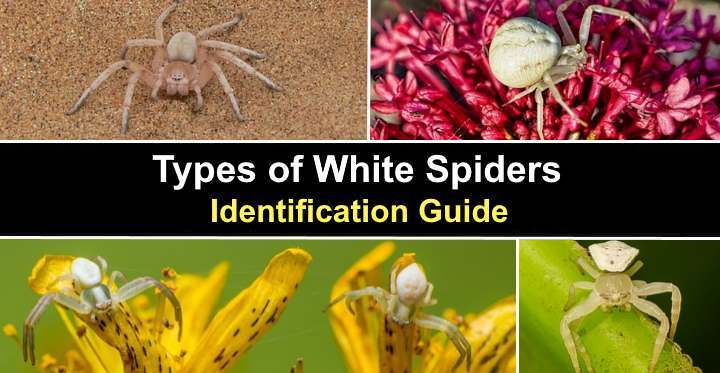
White spiders are unusual spiders because most spiders are black or brown. Compared to other spider species, there are fewer types of spiders with white bodies. It is also possible to easily mistake a white spider for another kind of bug or insect. Whether it’s a tiny white spider or a large, menacing cream-colored spider, seeing any kind of white arachnid scurrying across the floor can be terrifying.
If you come close to a white spider, you probably wonder if the spider is venomous. White spiders—like all spider species—contain a small amount of venom. The most common white spider, the goldenrod crab spider, is venomous and will inflict a stinging bite. However, crab spiders don’t have enough venom to be harmful to humans. Their bite usually only causes initial sharp pain like a bee sting.
This article is a guide to common and some not-so-common white spiders. Descriptions and pictures of the eight-legged pale-colored or white arachnids will help you identify the type of white spider you have found.
Facts About White Spiders
Most people would have difficulty identifying a species of white spider. The most common kinds of white spiders are crab spiders with bulbous creamy white abdomens and translucent segmented pale white legs. However, you’ll more likely find white crab spiders in gardens, woodlands, and grasslands.
If you notice a long-legged whitish spider in your house, it’s probably a yellow sac spider. You will see its distinctive amber cephalothorax, whitish egg-shaped body, and long white legs with black tips.
The good news is that white spiders in the house are unlikely to be harmful. The type of dangerous house spiders to be wary of are the brown recluse spider and the black widow spider. These venomous spiders can cause bites requiring medical attention.
How to Identify White Spiders
White spider identification is by their eight legs, white colored-abdomen and cephalothorax (head), six or eight eyes, and mouthparts (chelicerae). In addition, common white spiders have identifiable bulbous creamy white bodies. Other types of spiders can have white bodies with colorful markings, identifiable black spots, or spiny bodies and legs.
Like all spider species, white spiders are eight-legged creatures with two body segments in the class Arachnida. This means that spiders differ from insects, which have six legs and three segmented body parts. Other differences between spiders and insects are that spiders have simple eyes, no antennae, and never have wings.
It’s also possible to identify species of white spiders by the webs they spin. Some spiders are known as tangle web spiders that spin messy webs. White orb spiders spin beautiful circular webs to catch prey. Other white spider species spin funnel webs for protection or laying eggs.
Are White Spiders Venomous?
White spiders are venomous, which is a characteristic trait of all species of spiders. The spiders use their venom to kill prey by injecting it with their mouthparts. However, most white spiders are not harmful to humans because they only inject a relatively small amount of venom.
There is a type of white widow spider that is highly venomous—the white widow spider. However, this spider is only found in certain parts of Asia and the Middle East and is relatively rare.
Do White Spiders Bite?
White spiders have the potential to bite because all spiders have chelicerae—jaws with fangs or pincers. However, like all spiders, white spiders typically only bite when they feel threatened. A small or large white spider bite may feel like a bee sting that starts painful and causes a burning sensation.
Most species of white spider, like the yellow sac spider, lurk under leaves, stones, or debris in the garden. Therefore, most bites from a white spider happen while gardening in the summertime. In some cases, the bite from a white spider can be as painful as one from a brown recluse.
Types of White Spiders (with Pictures) – Identification Guide
Let’s look in more detail at the various identifying characteristics of white spiders you are likely to find in your house or yard.
Goldenrod Crab Spider (Misumena vatia)
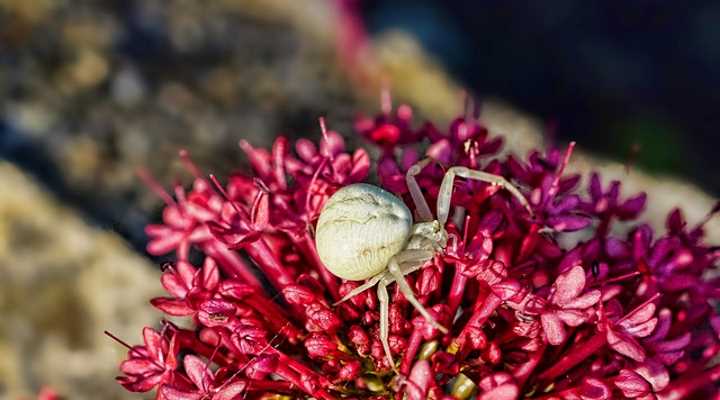
The goldenrod crab spider is identified by its large round white body, although it can turn yellow for camouflage
The goldenrod crab spider is a common species of white spider you’ll find in your garden. The female spiders tend to be bright white, with an enlarged, bulbous abdomen, relatively small head, and crab-like legs. The tiny white spiders measure around 0.4” (10 mm), and the male spiders are half the size.
An identifying characteristic of all white goldenrod crab spiders is camouflage. Although the immature spiders emerge white, they can turn different colors, depending on the flowers they inhabit. For example, the white spiders can turn yellow when on yellow flowers, then return to bright white.
White Spider Identification: The identifying traits of a goldenrod crab spider are its large egg-shaped body, eight eyes, and ability to walk sideways. You will often find goldenrod crab spiders on milkweed or goldenrod flowers.
Caribbean Crab Spider (Misumessus)
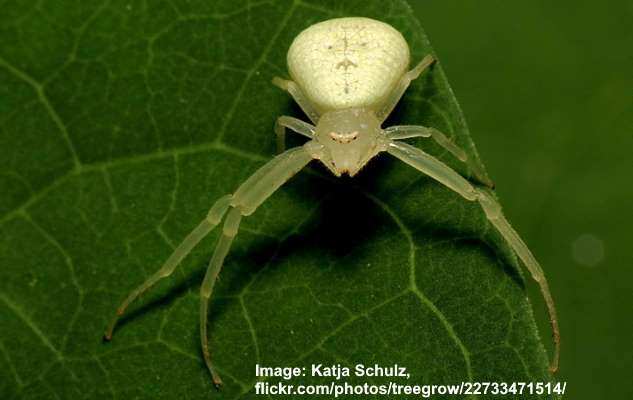
The tiny Caribbean crab spider has four long forelegs and tear shaped white body
White Caribbean crab spiders is a strange-looking spider that has a flattened tear-shaped body, translucent greenish-white head and legs, and tiny chelicerae. The minuscule white spiders measure between 0.16” to 0.23” (4 – 6 mm) long. Like most spiders, the females are larger than the males.
White Caribbean crab spiders are common throughout the United States. The white spiders are common in Florida, where you can find them in gardens, parks, and woodlands. The unusual feature of this white spider is its four long forelegs and four short hind legs.
White Spider Identification: The white Caribbean spider has a recognizable white abdomen with gray-brownish speckled patterns, greenish-white translucent legs, and a pointed head with two rows of black eyes.
White Crab Spider (Thomisus spectabilis)
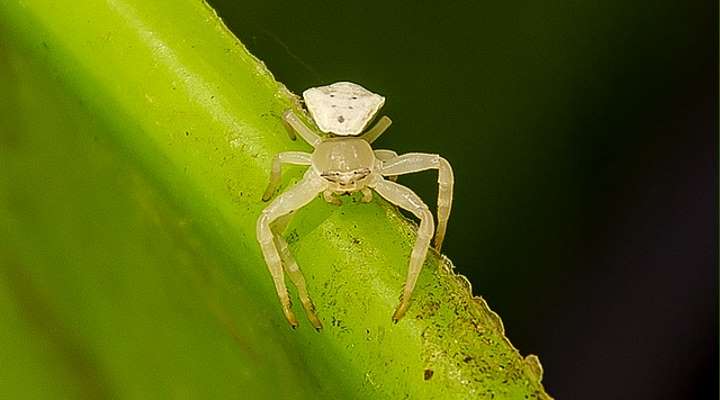
The small white crab spider has a venomous bite but is harmless to humans
Also called the Australian crab spider, this white arachnid has a white body, translucent pale white legs, and reddish or black spines on its legs. The tiny white spider measures 0.4” (10 mm) long with a leg span up to 1.2” (30 mm). A characteristic feature of this spider is its ability to change from white to yellow.
The white crab spider is known for its aggressiveness and venomous bite. A bite from the white hunting spider can leave a painful red mark and some swelling. However, the tiny whitish spider is not harmful to humans.
White Spider Identification: The white crab spider has a recognizable white abdomen, pale white cephalothorax, and translucent legs.
Yellow Sac Spiders (Cheiracanthium)
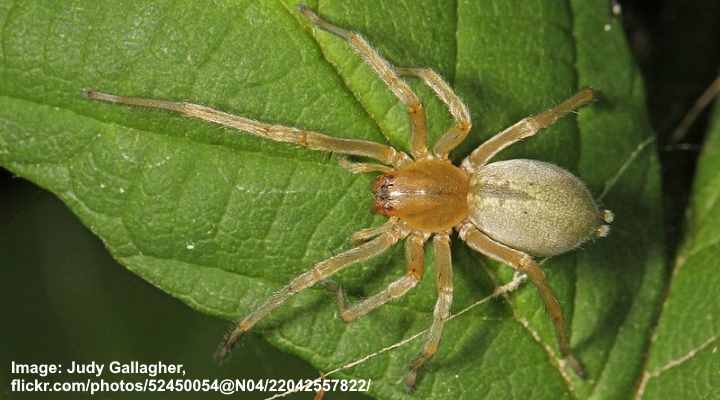
The yellow sac spiders have creamy abdomen and are common house spiders
Yellow sac spiders have a yellowish-white, sometimes tan body and long legs. This common white house spider has identifiable spindly legs that neither point outward nor inward. The spider’s oval body has white speckling with an oblong greenish mark on its back. Yellow sac spiders are tiny spiders whose average size ranges from 0.2” to 0.4” (5 – 10 mm).
Yellow sac spiders are common house spiders that can give a nasty bite. The venomous spiders’ yellowish and white coloring helps differentiate them from brown recluse spiders. A bite from these whitish spiders can cause pain, swelling, and blistering.
White Spider Identification: Yellow sac spiders are a cream to light yellow color with green tinges.
Dancing White Lady Spider (Leucorchestris arenicola)
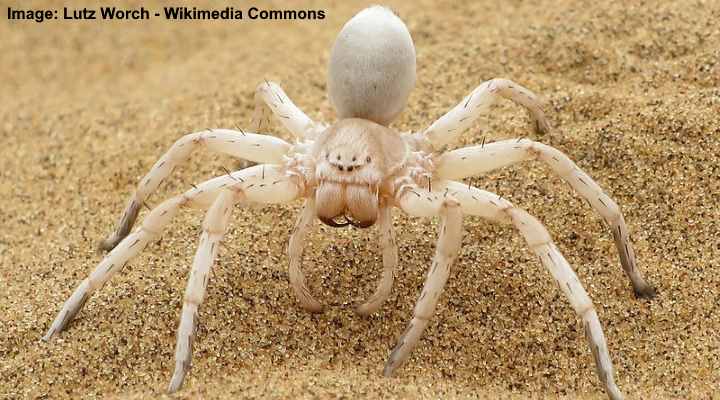
The nocturnal large dancing white lady spider has black spines on its legs
Dancing white lady spiders are all white spiders that come out at night. The menacing spiders have a body shape like an egg, white legs with black spines, and large pointed chelicerae. Like many white spider species, the dancing white lady has two rows of four eyes.
These huge white spiders measure 5” (13 cm) with a leg span of 10” (250 mm). You can recognize the large spiders by their creamy white shading.
Dancing white lady spiders are found in the deserts of Namibia. The nocturnal white spider lives in burrows in the sand. Therefore, it’s rare to spot one of these giant white spiders.
White Spider Identification: The dancing white lady spider is identified as a sizable white spider that only comes out at night and lives in burrows.
Shortbodied Cellar Spider (Spermophora senoculata)
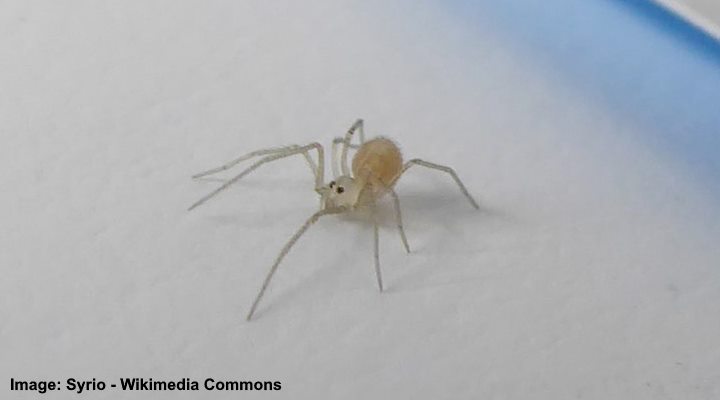
The tiny shortbodied cellar spider has whitish head with two pronounced eyes and a round darker abdomen
The short-bodied cellar spider is a small whitish-tan colored spider with a round abdomen, thin white legs, and tiny cephalothorax. The little white spider is identified by its globular white body with several faint brown coloration or dark marks. The minuscule spiders measure 0.08” (2 mm) long.
The shortbodied cellar spider is native to Asia and is found throughout the Mediterranean region and southern states of the US. As its common name suggests, the whitish spider lives in caves, damp, dark rooms, under stones, and in cellars.
White Spider Identification: The whitish short-bodied cellar spider is identified by its pale white translucent cephalothorax and legs, pale tan spiny ball-like abdomen, and two pronounced simple eyes.
White Widow Spider (Latrodectus pallidus)
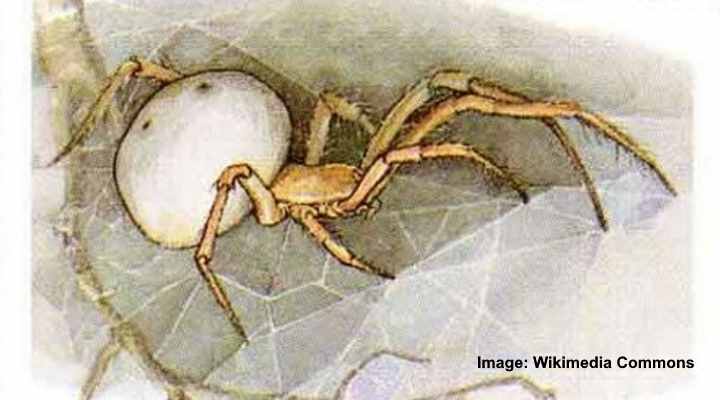
The white widow spider is a rare type of spider with a large round abdomen
The white widow spider is a rare spider species in the widow genus Latrodectus and family Theridiidae. White widows are unique because most widows are black with an identifiable red hourglass marking. The tiny white spiders measure 0.4” (10 mm) in size.
Also called the white steppe spider, these white spiders are rarely seen in the wild. Like the black widows, the white species have a nasty bite that can cause serious health issues in children, requiring medical attention. The bite of the white spider is described as “mildly venomous.”
White Spider Identification: The white widow spider has a large, bulging, bulbous white abdomen with a pale tan-colored cephalothorax and legs.
Colonus puerperus
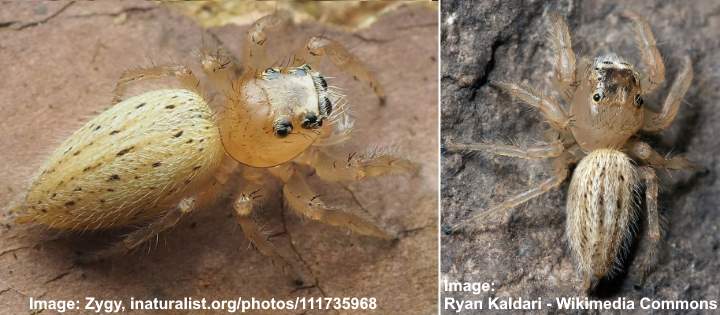
Female colonus puerperus spiders are jumping spiders with whitish hairy abdomen
One of the few white hairy jumping spider species is the Colonus puerperus. The fuzzy white adult female spider has a pale tan body with hairy white stripes. Like other species of jumping spiders, the spiny spider has several eyes, with two pronounced black eyes above its jaws.
White Colonus puerperus is found in Florida, Texas, and around the Gulf Coast. You will sometimes see the little whitish spider in grassy areas during the summer. The spider, with its oblong oval white and tan body, measures 0.2” to 0.3” (5 – 7 mm) long. Due to its stumpy spiny legs and white fuzz, the spider looks like a white tarantula.
White Spider Identification: Colonus puerperus is identified by its whitish striped furry abdomen, spiny tan legs, and eight eyes on its pale brown cephalothorax.
Ghost spiders (Anyphaenidae)
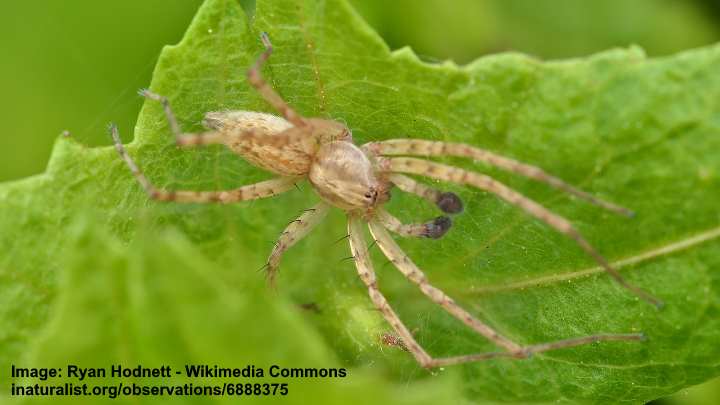
Ghost spiders have creamy white body with pale brown markings, spiny legs and pronounced pedipalps
Some species of ghost spiders are identified by their oblong, pointed abdomen, and creamy-white body with a pale brownish triangular abdominal stripe. Up close, pictures of these whitish-brown spiders show they have black spines on eight long legs. Other identifiable features are the two extended pedipalps that look like a pair of black boxing gloves.
The small yellowish-white or pale brown-white spiders typically measure 0.15” – 0.3” (4 – 8 mm) long. Another identifiable feature of ghost spiders in the family Anyphaenidae is that the two central eyes on the bottom row are the smallest.
White Spider Identification: The whitish ghost spider has a recognizable pointed abdomen, pale tan legs with black spines, and two rows of four eyes.
Yellow Ghost Spider (Hibana velox)
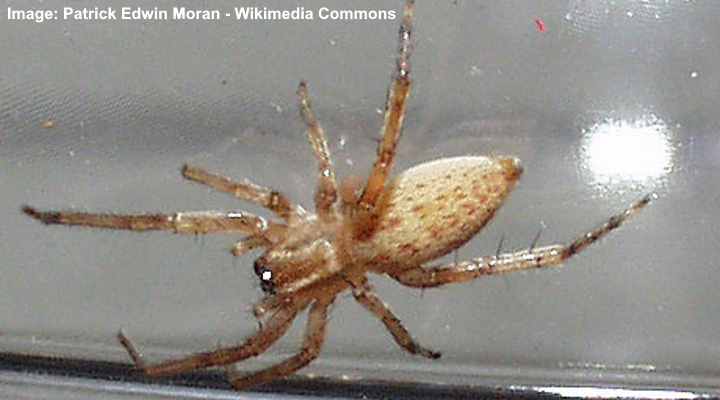
The yellow ghost spider has white and tan body with a pointed abdomen and spiny legs
The yellow ghost spider is a common house spider with a whitish-tan body and orangey-brown pattern on its abdomen. Like other species of ghost spiders, Hibana velox has a pointed abdomen with a pronounced spinneret at its tail end. The small pale-colored spider measures around 0.16” (4 mm) long.
The yellow ghost spider is often found in homes and gardens throughout the United States. Due to its pale brown or light tan coloring, the spider can appear whitish from a distance. The yellow ghost spider is also easy to mistake for a brown recluse spider.
White Spider Identification: To identify the yellow ghost spider, look for pale tan markings on a creamy-white pointed abdomen. Like most ghost spiders, this variety has black spines on its legs.
Garden Ghost Spider (Hibana gracilis)
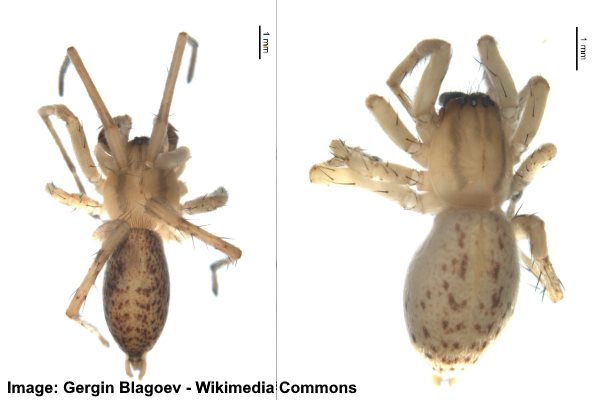
Garden ghost spider: male (left) and female (right)
The adult female garden ghost spider has a bulbous creamy-white abdomen with dark brown spots. Other identifying features of this white ghost spider are spiny legs, two rows of simple eyes, and dark stripes on its tan or beige head. Garden ghost spiders measure around 0.28” (7 mm) long.
Garden ghost spiders are generally found in the northeastern United States. The yellow to white spider with its longitudinal dark stripes and dark spots and its brown chelicerae help identify the garden ghost spider.
White Spider Identification: To identify the garden ghost spider, look for its pale tan, whitish body and legs, dark brown spots or markings on its abdomen, and dark stripe on its cephalothorax.
Common Candy-Striped Spider (Enoplognatha ovata)
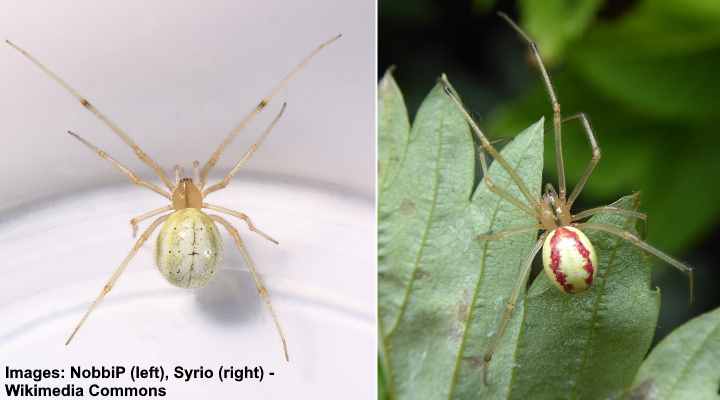
The common candy-striped spider is a small white spider with red or pale green markings and long legs
The common candy-striped spider has a bulbous white abdomen with pronounced V-shaped red or pale green stripes. Up close, pictures of this white spider reveal tiny black dots on its body and fine black hairs covering its long spindly legs. The white candy-striped spider measures 0.23” (6 mm) long.
Despite the small size of this white spider, its long legs make it appear larger. Although the spider typically has a white body, it can also be cream or green. The colorful markings on its back generally appear as a V-shape and can be in various colors.
White Spider Identification: The common candy-striped spider has a white or cream-colored globular abdomen, translucent legs, and red or greenish bands on its back.
White Florida Crab Spider (Gasteracantha cancriformis)
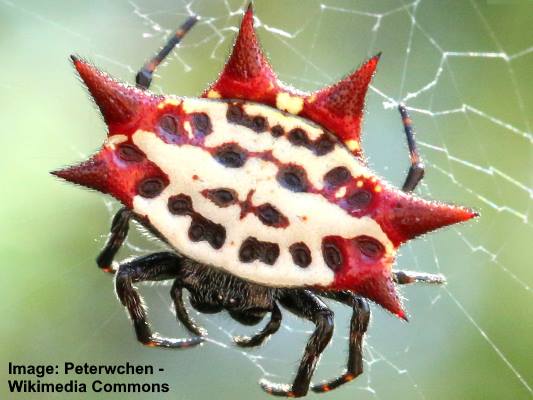
The unique and unusual looking white Florida crab spider can be easily identified by its six red or black spines
Also called spiny-backed orb spiders, the Florida crab spider is one of the most unusual white spiders you will come across. The spider’s brilliant white abdomen is covered with black dots and six pronounced red or black spines. The distinctive trait of the spider is its crab-like appearance with a large, broad abdomen and a small head.
White adult spiny-backed orb-weaver spiders measure 0.4” to 0.5” (10 – 13 mm) wide and up to 0.35” (9 mm) long. The white and black or white and red spider is found in North America in shrubby gardens and woodlands.
The spiny-backed orb-weaver is also called the Florida crab spider. The white spider constructs ornate webs to trap insects. Then the white Florida crab spider bites its prey to paralyze it before wrapping it in silk.
White Spider Identification: The easy to identify white Florida orb-weaver spider has a unique brilliant white abdomen, covered in black dots and six triangular red or black spines. Its unusual shape means the tiny white spider has an abdomen that is broader than long.
Related articles:
